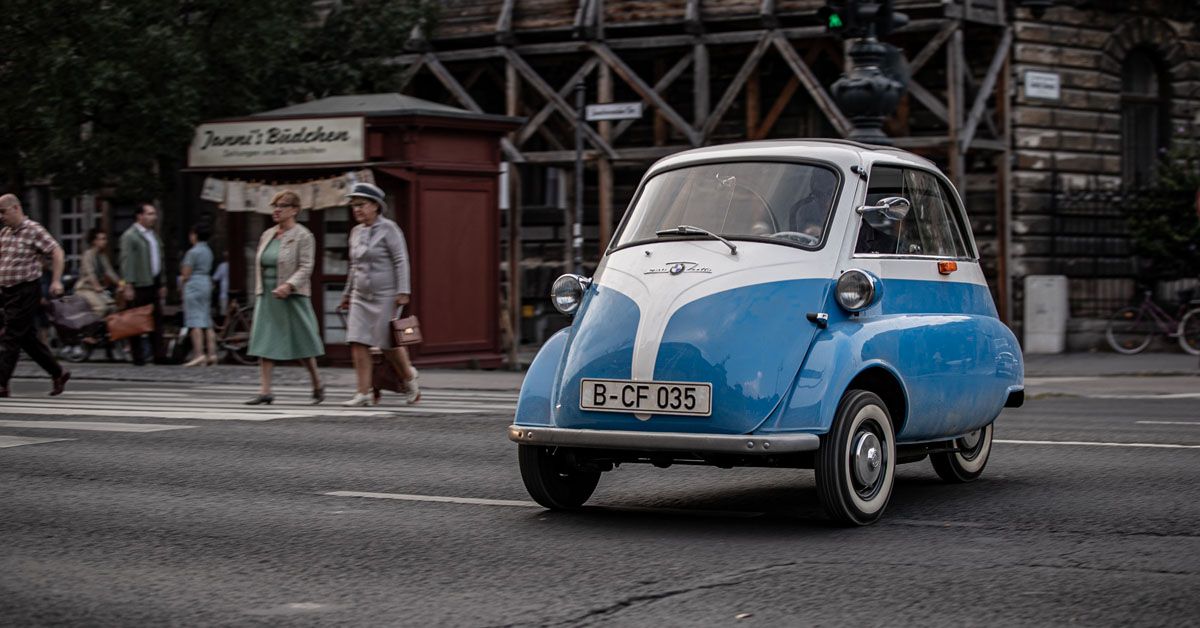The auto industry has come a long way since the first automotive assembly line for mass-producing cars debuted in 1913. BMW, on the other hand, began its life as an aircraft engine manufacturer, and then started making motorcycles before it finally graduated to make cars.
Today, the name “BMW” is synonymous with fireball performance and class-leading capability. But even it floundered in the ‘50s, teetering on the edge of bankruptcy and desperately needing a product that could save it from eventual annihilation.
It was then when one of the smallest cars in the world, and also rather oddly shaped and built, came to BMW’s rescue. This is the story of BMW Isetta, a tiny little oddball that looks incongruous when placed next to BMW’s luxurious fleet, and yet managed to throw the automobile company a lifebuoy, when it needed one.
BMW Faced Bankruptcy In The Mid-50s
BMW’s automotive journey began in 1916 as Bayerische Flugzeug-Werke, a manufacturer of aircraft engines, but it became Bayerische Motoren Werke in July 1917. The fledgling company took the plunge into the automobile whirlpool by launching the BMW R32 motorcycle in 1923. It set the world speed record that remained unbroken until 1937. Riding on its success, BMW started manufacturing its first production car, the Dixie 3/15 which was essentially a licensed copy of the Baby Austin, one of the most popular British economy cars of its era. In 1932, the company launched its first in-house designed car called the BMW 3/20 which changed the course of its automotive journey. BMW was on a winning streak and rolled out a bunch of successful cars but the looming WWII severely affected the pace of its motorcycle business.
In 1951 as the company debuted its first post-WWII car, the luxury-overloaded BMW 501 was soon followed by the 503 and 507. By the mid-50s, BMW was on the brink of a financial crisis as the motorcycle business was failing and the company couldn’t cope with high production costs associated with poor-selling 501, 503, and 507 models.
A Lifesaver Was Born In Italy
Marred with a cash crunch, BMW decided to bring out a car that was low on production cost and could earn profits right away even if it was in small amounts. In 1955, the BMW Isetta was born out of this misery. It eventually lifted the company’s morale overnight and went on to become one of the most iconic cars of the 50s.
It also became the world's first mass-production car to achieve a fuel consumption of 78 MPG, though the fuel tank held only 3.4 gallons of gas. The first Isetta was introduced in 1953 by its original Italian automaker, ISO Rivolta who was known for its refrigerators, scooters, and microcar business for the masses.
The Iso Isetta, also dubbed as 'The Bubble Car', had a sensational debut at the 1954 Turin Car Show and two years later BMW came up with its version. It sported the same design but carried BMW’s underpinnings including a 250-cc 4-stroke single-cylinder engine borrowed from the BMW R25/3 motorcycle. The transmission duties were handled by a 4-speed manual while it took more than 30 seconds to glide to 31 MPH from a standstill. This single-cylinder mill coughed up only 13 horses and an equal amount of torque but the fuel economy was massive which was perfect for the low-economy time of post-WWII.
The Cult Classic BMW Isetta Became A Bestseller
The first BMW Isetta rolled off the assembly line in April 1955 and raked in a lot of admiration from the buyers. Within the next eight months, BMW collected 10,000 more orders that set the ball rolling for BMW’s recovery from bankruptcy. It soon became the world’s best-selling single-cylinder car that changed the fortunes of BMW.
The Isetta was so small that it measured only 4.5 feet wide and 7.5 feet long, and there was space for only two passengers. This oddball was shaped liked an egg as its body narrowed towards the rear. Even more interestingly, the single door on the car opened across the front of the vehicle. It was unlike any other car of its era as every time you opened the door the steering wheel and instrument panel would also swing open, as they were attached to the door.
In case someone parked too close to the front of the car and blocked your ingress, there was a canvas-covered opening in the roof, which you could use in case of emergency. Nifty, right?
BMW sold a total of 161,728 Isettas worldwide until 1962 before the company drew the curtains on this money-spinning car. Later, BMW Isetta became a global phenomenon when it was featured in Family Matters as Steve Urkel’s “Clown Car.” The popular TV series aired from September 22, 1989, to May 9, 1997, and is today remembered as one of the longest-running sitcoms of all time. It also put an eternal spotlight on the bubble car that may have been considered funny, but turned out to be a lifesaver for BMW in the long run.
Sources: BMW, Forbes


.jpg)
.jpg)
.jpg)